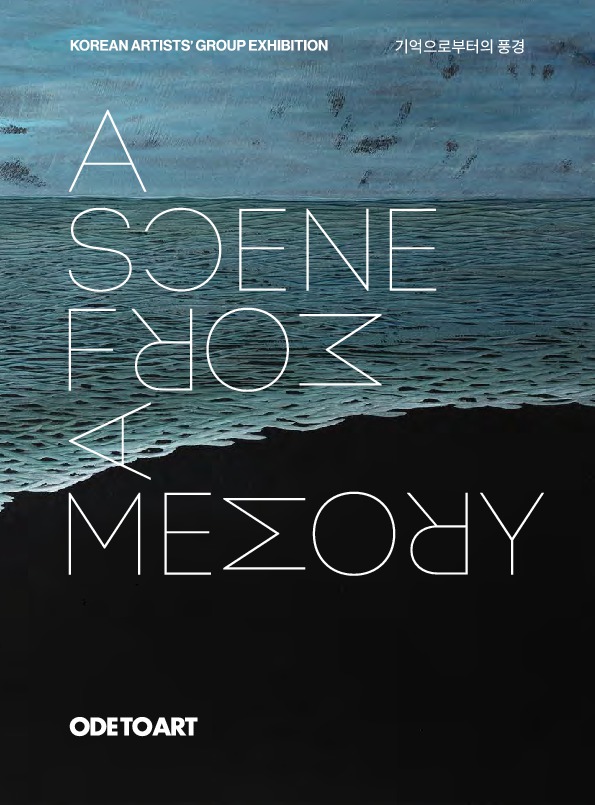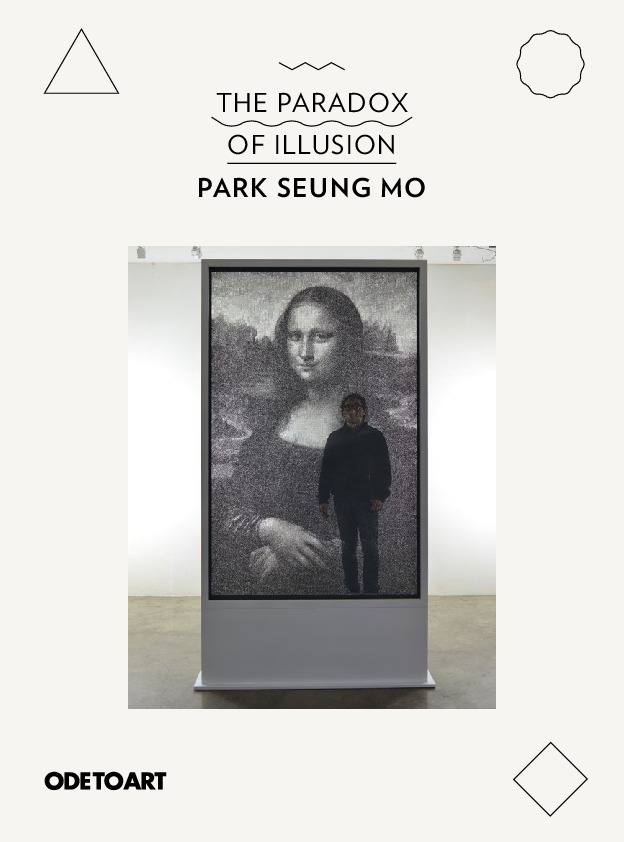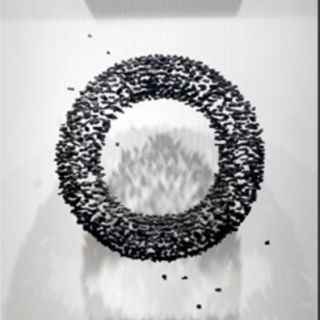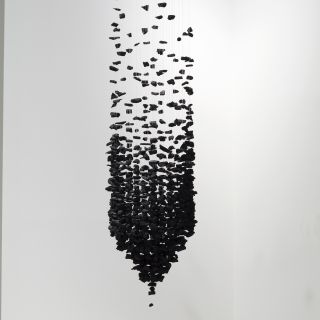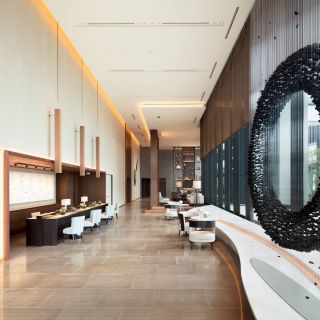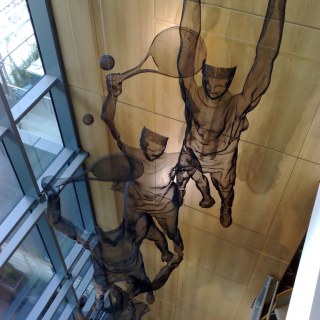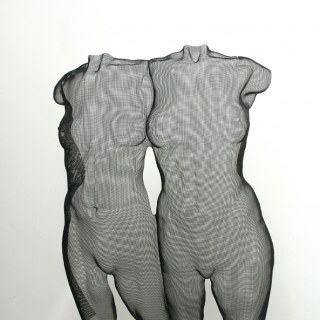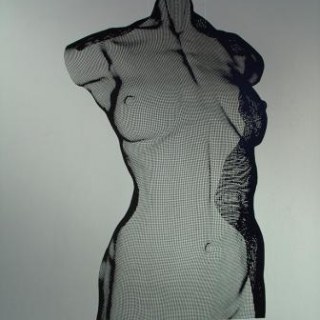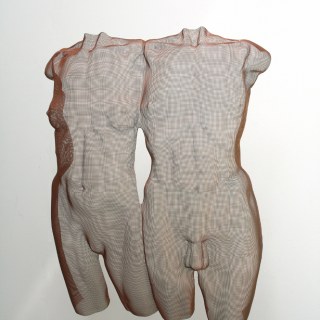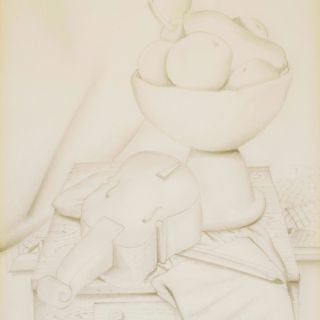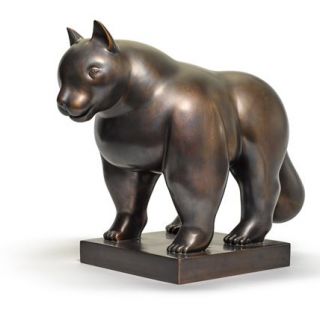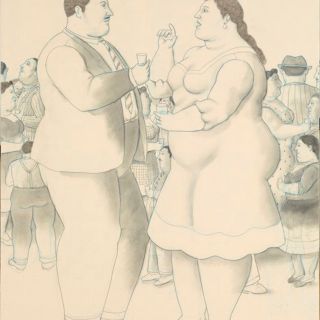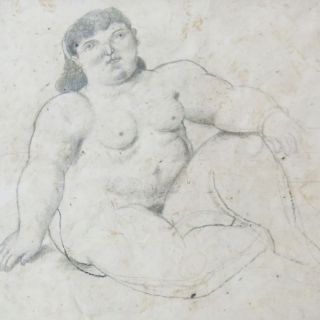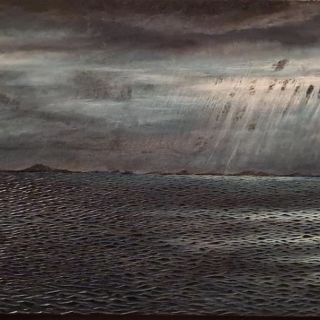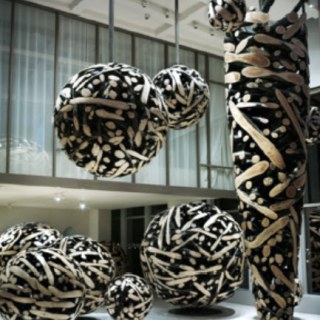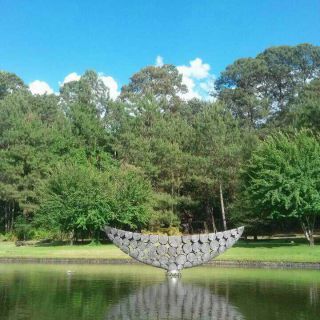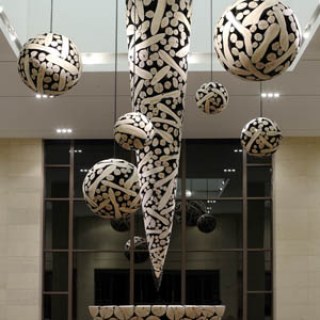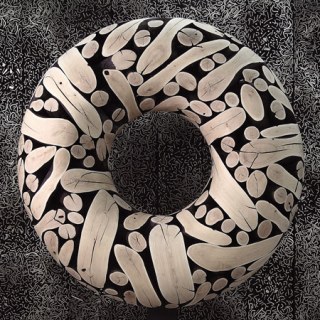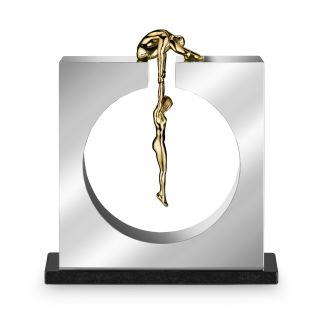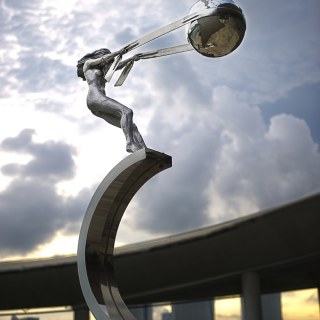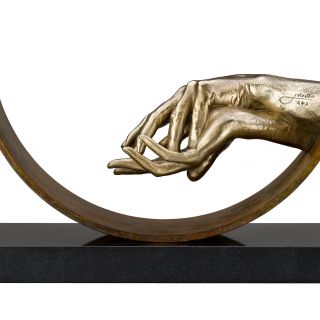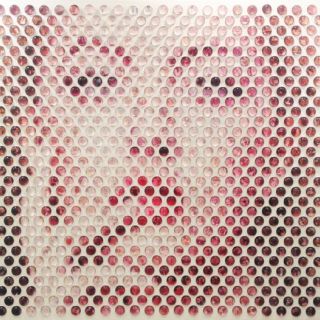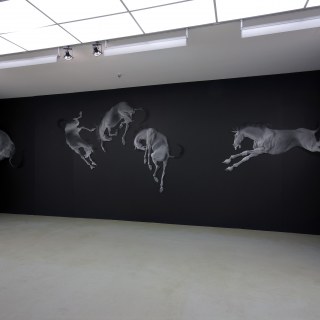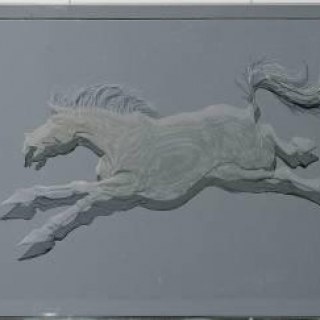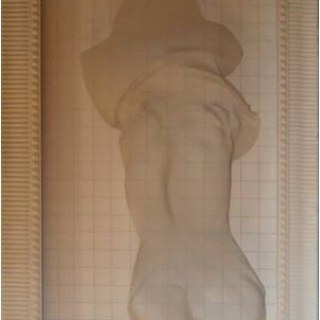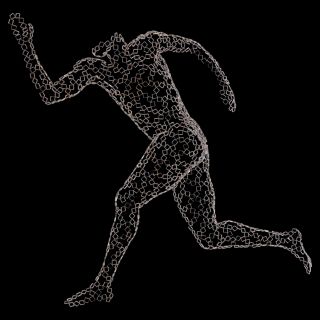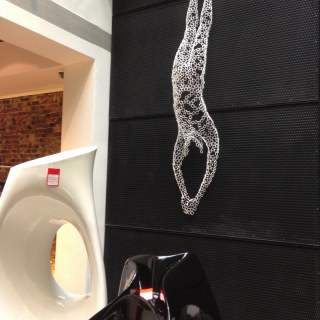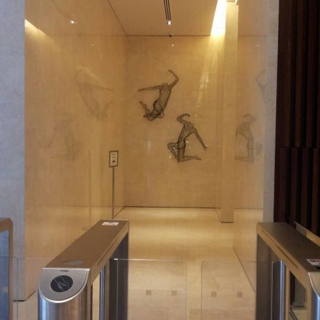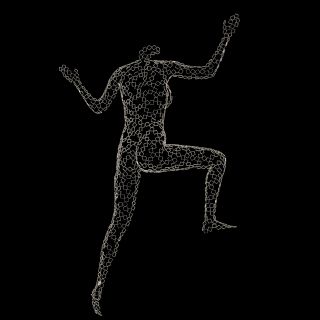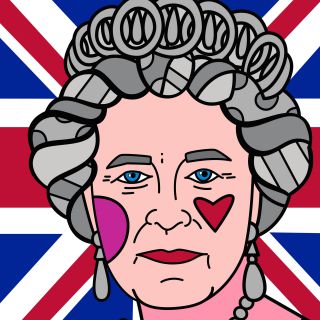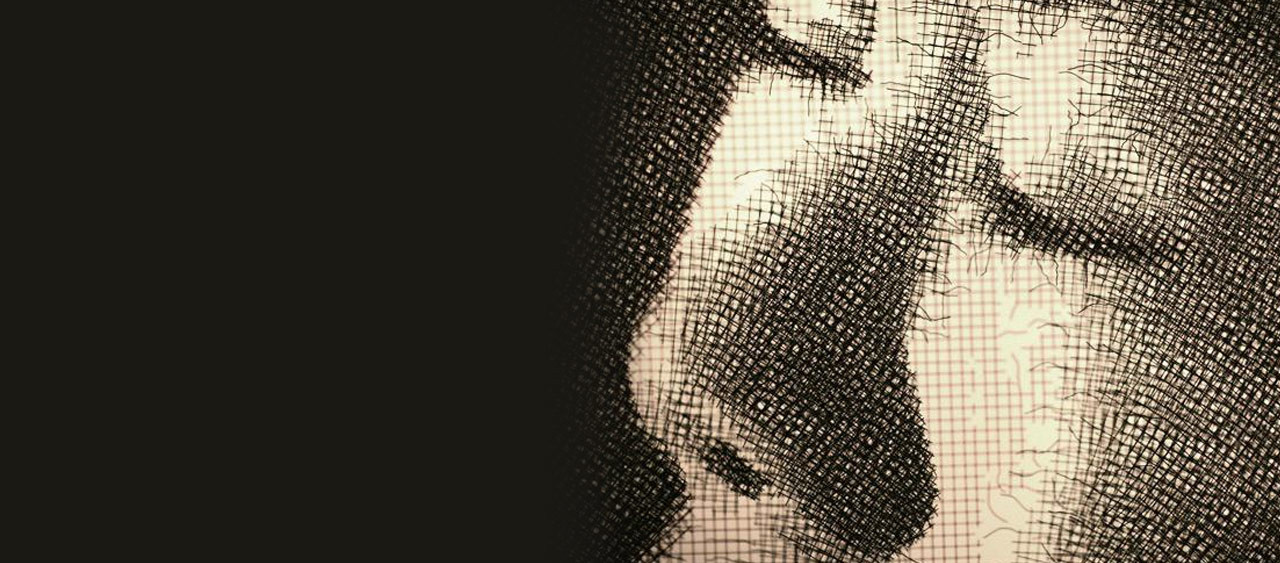
Born in Korea in 1969, Park Seung Mo graduated from Dong-A University with a Bachelor of Fine Arts in 1998 and is based in Brooklyn. He explores fundamental ideas through the use of forms, creating large ephemeral portraits by layering frames of wire mesh together and cutting through the layers to create depth. Each work begins with a photograph which is superimposed upon the overlapping layers of wire with a projector. He then employs a subtractive technique of snipping away areas of mesh and netting. Each piece is several inches thick and the plane that forms the final image contains spaces that are a few finger widths apart, which contribute depth, movement and dimensionality to the portraits.
In works such as Mong-hwan (Fantasy), Hwan-sang (Illusion) and Hwan-myeol (Disillusion), Park speaks of ‘hwan’ or fantasies and visions that feel as if they were real. He turns these fantasies into visual illusion of wire and explains “what is important for me is showing the audience the moment where the boundary between the real and the illusion break down.”
Viewing 11 works by Park Seung Mo
Sort
Biography 
Biography
Born in Korea in 1969, Park Seung Mo graduated from Dong-A University with a Bachelor of Fine Arts in 1998 and is based in Brooklyn. He explores fundamental ideas through the use of forms, creating large ephemeral portraits by layering frames of wire mesh together and cutting through the layers to create depth. Each work begins with a photograph which is superimposed upon the overlapping layers of wire with a projector. He then employs a subtractive technique of snipping away areas of mesh and netting. Each piece is several inches thick and the plane that forms the final image contains spaces that are a few finger widths apart, which contribute depth, movement and dimensionality to the portraits.
In works such as Mong-hwan (Fantasy), Hwan-sang (Illusion) and Hwan-myeol (Disillusion), Park speaks of ‘hwan’ or fantasies and visions that feel as if they were real. He turns these fantasies into visual illusion of wire and explains “what is important for me is showing the audience the moment where the boundary between the real and the illusion break down.” The work itself is photorealistic and transfixes viewers, while the figures are ghostly, ethereal and hauntingly evocative. His craftsmanship and flair is evident as he is able to create both three-dimensional sculptures as well as pieces that imitate the graininess found in two-dimensional photographs.
Exhibitions 
Exhibitions
Selected Exhibitions
2018
Contemplation, Gallery BK, Seoul, Korea
Insight into the True Nature of Reality, Saasfee Pavillon, Germany
Beware of the Seductive Traps of Spiritual and Psychic Power, Magicbeans Gallery, Germany
The Butterfly Dream, Galerieverein Leonberg, Germany
2017
Threads of a Story, Art Issue Projects, Taipei City, Taiwan
The Butterfly Dream (胡蝶夢), Posco Art Museum, Seoul, Korea
2016
Young (影), Avenuel Art Hall, Lotte World Tower, Seoul, Korea
2015
The Paradox of Illusion, Ode to Art, Singapore
2014
Meticulously Snipped & Wrapped, Marshall M. Fredericks Sculpture Museum, Michigan, U.S.A.
Absence, HADA Contemporary, London, U.K.
Seungmo Park: Meticulously Snipped & Wrapped, Dennos Museum, Michigan, U.S.A.
2013
A Scene from A Memory, Ode to Art, Singapore (Group exhibition)
Art Issue Projects, Taipei, Taiwan
2012
Gallery Bundo, Daegu, Korea
A Present Moment, HADA Contemporary, London, U.K.
2011
幻 Solid Illusion, Gallery Absinthe, Seoul, Korea
2010
"Linear Utmost: Park Seung Mo Solo Exhibition," Taipei
2009
"Korean Eye Moon Generation," London
2008
"Park Seung Mo Solo Exhibition," Seoul
2007
"ACAF", New York; "Lines in Space," Kyunggi Gyeonggi-do
2006
"Shanghai Art Fair," Shanghai
2018
Contemplation, Gallery BK, Seoul, Korea
Insight into the True Nature of Reality, Saasfee Pavillon, Germany
Beware of the Seductive Traps of Spiritual and Psychic Power, Magicbeans Gallery, Germany
The Butterfly Dream, Galerieverein Leonberg, Germany
2017
Threads of a Story, Art Issue Projects, Taipei City, Taiwan
The Butterfly Dream (胡蝶夢), Posco Art Museum, Seoul, Korea
2016
Young (影), Avenuel Art Hall, Lotte World Tower, Seoul, Korea
2015
The Paradox of Illusion, Ode to Art, Singapore
2014
Meticulously Snipped & Wrapped, Marshall M. Fredericks Sculpture Museum, Michigan, U.S.A.
Absence, HADA Contemporary, London, U.K.
Seungmo Park: Meticulously Snipped & Wrapped, Dennos Museum, Michigan, U.S.A.
2013
A Scene from A Memory, Ode to Art, Singapore (Group exhibition)
Art Issue Projects, Taipei, Taiwan
2012
Gallery Bundo, Daegu, Korea
A Present Moment, HADA Contemporary, London, U.K.
2011
幻 Solid Illusion, Gallery Absinthe, Seoul, Korea
2010
"Linear Utmost: Park Seung Mo Solo Exhibition," Taipei
2009
"Korean Eye Moon Generation," London
2008
"Park Seung Mo Solo Exhibition," Seoul
2007
"ACAF", New York; "Lines in Space," Kyunggi Gyeonggi-do
2006
"Shanghai Art Fair," Shanghai
Critique 
Critique
Exploring being real and being existent from the Zen perspective
Sculpture of Park Seung-Mo
"An object clashes with another one and has its shell broken; the contents get dissolved and transformed into a soft protoplasm ready to receive new forms and structures. The cedar and the flames, two objects flow and get changed into abstract ones. Seen from the world which is neither metaphor nor poem, these objects represent the whole in itself, a terminal and an object of our consciousness."
-excerpts from Dehumanization of Art
Question: Are you real! Are you existent! (Excerpt)
Park Seung-Mo does not translate an object into a sculpture to simply represent the way it is.
This is neither meditation on human existence by a human being as Rodin did, nor is this a modern formal beauty which has to do with the inner nature of an object; nor the search for the essence of existence whose definition no longer exists,like Giacometti. The object of 'functionality' is a model, an object which establishes a form whose practicality is maximized by a human being and the aura of the contour of the object is sought after from the aesthetic point of view.
How the sculpture of Park Seung-Mo is understood and completed in the tradition of western philosophy doesn't seem to be far off from that of mimesis. This is because, as mentioned above in relation to 'deconstruction and subversion,' it is necessary to put an end to the concept of deconstructionism and simulacrum of Derrida, Gilles Deleuze and Jean Baudrillard. The aura of 'Zen' surrounding his sculpture also has to be addressed. Zen is to indicate directly what is existent. The question of 'what is this?' becomes enlightened through such an answer as 'this is a flower!' The moment of verification of the existence of truth leads to enlightenment.
Here is an episode. A Zen priest stumbled over a stone on his way to the toilet. At the very moment, he felt pain and the 'pain' became apparent. And now, he realized and saw 'pain' as a reality of Zen. Thereafter, he saw flowers, the moon, trees, the universe and Buddha. He realized that the flowers are 'me', the trees are 'me' and the whole universe is 'me'. That is, Buddha is 'me'. Park Seung-Mo names the bike, a bike; the rocking chair, a rocking chair. Through his work which turns reality into existence, he meditates on the question of 'what is this?'. However, there is no entity asking 'what is this?' This question of the absence of an entity forms the shape of his works. The bike is not a bike and Buddha is not Buddha. The plow is not a plow and the kettle is not a kettle. Rodin is not a thinker. And if so, where is the reality?
Excerpt from Experience: Seeing an Illusion of Mandala
Park Seung-Mo traveled to India in the mid-1990s and spent nearly five years there practising meditation and ascetic exercises. The experience significantly influenced his life and art. This was not about meditation being practiced in a tightly enclosed space such as a temple or a cavern; this was the active practicing of meditation on the road, which was a process of overcoming the ceaseless fear of the world; this was also a moment of witnessing how the absolute value of art and wholeness of beauty could be dismantled in vain. He also confronted the reality of the self, which he longed for all this while. This is not to exaggerate to say that he became awakened to 'enlightenment,' rather, the fact is that he clung to a question and explored the abyss of life, finally encountering an inner essence that could provide an important clue to the understanding of his works.
"At the Osho Rajneesh Meditation Center, there is a healing room for those afraid of the dark. Deep underground, there are rooms. The deeper you go underground, the darker it becomes. Upon reaching the last room, it becomes pitch black and you have to stay there for two hours. The dark will not open itself to you and at the moment of giving up the expectation of seeing the dark soon, the dark overwhelms you. That is what death is all about and also the moment of encountering yourself seized with fear. That is, to encounter the self that he himself threw out of him."
-Gigeon Culture & Art, page 58, Volume 172, 2005, Gyeonggi Cultural Foundation Publishing. Co. -excerpts from an article of Park Seung-Mo on his experience at the Osho Rajneesh Meditation Centre
To find the reality of 'the dark' in the dark with no glimmer of light is to encounter 'the self'. In the dark, you cannot tell whether you are on the ground, lying or standing. The absolute silence and closed space unleash an imagination which is so overwhelming that it makes your whole body sweat. This is so dominating that you are obsessed with the thought of it collapsing suddenly and fear that you will not survive anymore being trapped in the dark. You feel like vomiting and want desperately to hang on to anything. Probably, this is what people experience when they claim that 'life runs amok." How could it be otherwise when confronting death and the dark? The enormous fear starts disappearing as you find the reality of the dark and the self. Oh, goodness, this is the dark! This is fear! This is me who is fearful! At this moment of awakening, all evil spirits vanish in a moment and serenity takes their place. This is the state of tranquility where there is no life or death. This experience helped Park Seung-Mo to overcome the fear of 'the dark' that plagued him for so long. He used to sleep at night with lights turned on, but no longer needed to.
Molding : Grasping the Reality of Illusion
(Excerpt)
However, what should be seen at the completion of imitation which is void of reality? This is the irony and essence of his work. Something which can be found everywhere, yet, cannot be seen clearly - the 'ego' of every object and 'ego' of self. He put the reality of 'ego' into an empty plastic mass. Being existent is not important, what I can touch, see and feel is not the only thing that is important. Such as he acquired serenity in the dark, he is trying to verify the reality of an object through making the reality of 'the dark' into being. That is, externally, his sculpture shows the outer aura of an object; yet, internally, it is the essence and the darkness of the object. To prevent the awakening from getting lost within itself, he hangs onto the reality and creates a mandala on the surface of the mass. The only difference here is that he uses aluminium rather than powdered stone. The aluminium coil on the surface of the work indicates the trace of long hours of toil. The elaborate coiling starting from one point to the completion resembles the process of mandala being produced. He is very meticulous and completely devotes himself to the work. In appearance, it looks pretty decorative. It is appealing. It has been molded quite well. However, we need to think about 'the planning of Park Seung-Mo' as we do with 'the planning of Magritte.' Magritte's work has 'a mysterious moving force while not referring to a pipe picture for a real picture; and not referring to a pipe picture for a letter picture.' He makes sure his paintings 'they are not the illusion or replica of 'a real pipe' but are illusions or replicas which have their own existence. That is how he plans 'the birth of illusionary beings in the twisting.' Park Seung-Mo adds an eastern speculation to the planning. This way, he completes the mandala of his own.
Kim Jong-Gill
Art Critic
Sculpture of Park Seung-Mo
"An object clashes with another one and has its shell broken; the contents get dissolved and transformed into a soft protoplasm ready to receive new forms and structures. The cedar and the flames, two objects flow and get changed into abstract ones. Seen from the world which is neither metaphor nor poem, these objects represent the whole in itself, a terminal and an object of our consciousness."
-excerpts from Dehumanization of Art
Question: Are you real! Are you existent! (Excerpt)
Park Seung-Mo does not translate an object into a sculpture to simply represent the way it is.
This is neither meditation on human existence by a human being as Rodin did, nor is this a modern formal beauty which has to do with the inner nature of an object; nor the search for the essence of existence whose definition no longer exists,like Giacometti. The object of 'functionality' is a model, an object which establishes a form whose practicality is maximized by a human being and the aura of the contour of the object is sought after from the aesthetic point of view.
How the sculpture of Park Seung-Mo is understood and completed in the tradition of western philosophy doesn't seem to be far off from that of mimesis. This is because, as mentioned above in relation to 'deconstruction and subversion,' it is necessary to put an end to the concept of deconstructionism and simulacrum of Derrida, Gilles Deleuze and Jean Baudrillard. The aura of 'Zen' surrounding his sculpture also has to be addressed. Zen is to indicate directly what is existent. The question of 'what is this?' becomes enlightened through such an answer as 'this is a flower!' The moment of verification of the existence of truth leads to enlightenment.
Here is an episode. A Zen priest stumbled over a stone on his way to the toilet. At the very moment, he felt pain and the 'pain' became apparent. And now, he realized and saw 'pain' as a reality of Zen. Thereafter, he saw flowers, the moon, trees, the universe and Buddha. He realized that the flowers are 'me', the trees are 'me' and the whole universe is 'me'. That is, Buddha is 'me'. Park Seung-Mo names the bike, a bike; the rocking chair, a rocking chair. Through his work which turns reality into existence, he meditates on the question of 'what is this?'. However, there is no entity asking 'what is this?' This question of the absence of an entity forms the shape of his works. The bike is not a bike and Buddha is not Buddha. The plow is not a plow and the kettle is not a kettle. Rodin is not a thinker. And if so, where is the reality?
Excerpt from Experience: Seeing an Illusion of Mandala
Park Seung-Mo traveled to India in the mid-1990s and spent nearly five years there practising meditation and ascetic exercises. The experience significantly influenced his life and art. This was not about meditation being practiced in a tightly enclosed space such as a temple or a cavern; this was the active practicing of meditation on the road, which was a process of overcoming the ceaseless fear of the world; this was also a moment of witnessing how the absolute value of art and wholeness of beauty could be dismantled in vain. He also confronted the reality of the self, which he longed for all this while. This is not to exaggerate to say that he became awakened to 'enlightenment,' rather, the fact is that he clung to a question and explored the abyss of life, finally encountering an inner essence that could provide an important clue to the understanding of his works.
"At the Osho Rajneesh Meditation Center, there is a healing room for those afraid of the dark. Deep underground, there are rooms. The deeper you go underground, the darker it becomes. Upon reaching the last room, it becomes pitch black and you have to stay there for two hours. The dark will not open itself to you and at the moment of giving up the expectation of seeing the dark soon, the dark overwhelms you. That is what death is all about and also the moment of encountering yourself seized with fear. That is, to encounter the self that he himself threw out of him."
-Gigeon Culture & Art, page 58, Volume 172, 2005, Gyeonggi Cultural Foundation Publishing. Co. -excerpts from an article of Park Seung-Mo on his experience at the Osho Rajneesh Meditation Centre
To find the reality of 'the dark' in the dark with no glimmer of light is to encounter 'the self'. In the dark, you cannot tell whether you are on the ground, lying or standing. The absolute silence and closed space unleash an imagination which is so overwhelming that it makes your whole body sweat. This is so dominating that you are obsessed with the thought of it collapsing suddenly and fear that you will not survive anymore being trapped in the dark. You feel like vomiting and want desperately to hang on to anything. Probably, this is what people experience when they claim that 'life runs amok." How could it be otherwise when confronting death and the dark? The enormous fear starts disappearing as you find the reality of the dark and the self. Oh, goodness, this is the dark! This is fear! This is me who is fearful! At this moment of awakening, all evil spirits vanish in a moment and serenity takes their place. This is the state of tranquility where there is no life or death. This experience helped Park Seung-Mo to overcome the fear of 'the dark' that plagued him for so long. He used to sleep at night with lights turned on, but no longer needed to.
Molding : Grasping the Reality of Illusion
(Excerpt)
However, what should be seen at the completion of imitation which is void of reality? This is the irony and essence of his work. Something which can be found everywhere, yet, cannot be seen clearly - the 'ego' of every object and 'ego' of self. He put the reality of 'ego' into an empty plastic mass. Being existent is not important, what I can touch, see and feel is not the only thing that is important. Such as he acquired serenity in the dark, he is trying to verify the reality of an object through making the reality of 'the dark' into being. That is, externally, his sculpture shows the outer aura of an object; yet, internally, it is the essence and the darkness of the object. To prevent the awakening from getting lost within itself, he hangs onto the reality and creates a mandala on the surface of the mass. The only difference here is that he uses aluminium rather than powdered stone. The aluminium coil on the surface of the work indicates the trace of long hours of toil. The elaborate coiling starting from one point to the completion resembles the process of mandala being produced. He is very meticulous and completely devotes himself to the work. In appearance, it looks pretty decorative. It is appealing. It has been molded quite well. However, we need to think about 'the planning of Park Seung-Mo' as we do with 'the planning of Magritte.' Magritte's work has 'a mysterious moving force while not referring to a pipe picture for a real picture; and not referring to a pipe picture for a letter picture.' He makes sure his paintings 'they are not the illusion or replica of 'a real pipe' but are illusions or replicas which have their own existence. That is how he plans 'the birth of illusionary beings in the twisting.' Park Seung-Mo adds an eastern speculation to the planning. This way, he completes the mandala of his own.
Kim Jong-Gill
Art Critic

Stay connected.
Sign up to our newsletter for updates on new arrivals and exhibitions





